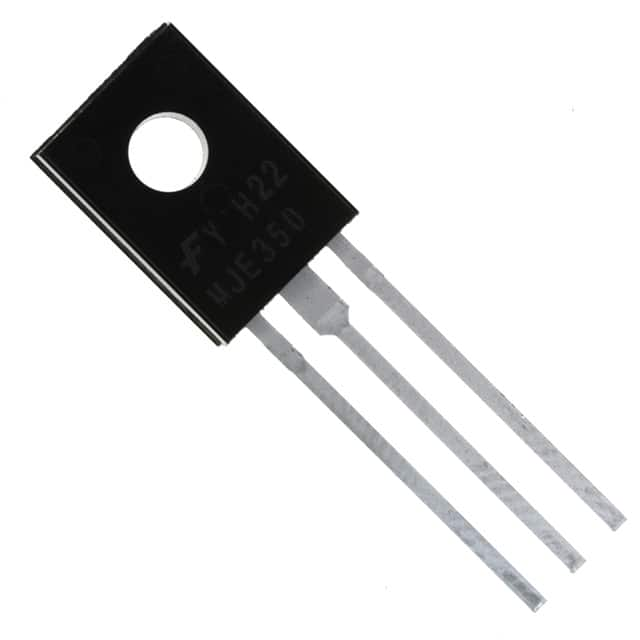KSE340S Product Overview
Introduction
The KSE340S is a semiconductor device belonging to the category of power transistors. This entry provides an overview of the basic information, specifications, pin configuration, functional features, advantages and disadvantages, working principles, application field plans, and alternative models of the KSE340S.
Basic Information Overview
- Category: Power Transistor
- Use: Amplification and switching of electrical signals
- Characteristics: High voltage and current capability, low saturation voltage
- Package: TO-220, TO-126
- Essence: Silicon NPN transistor
- Packaging/Quantity: Typically available in reels or tubes containing multiple units
Specifications
- Maximum Collector-Emitter Voltage (Vce): 400V
- Maximum Collector Current (Ic): 3A
- Power Dissipation (Pd): 40W
- DC Current Gain (hfe): 30 - 300
- Transition Frequency (ft): 4MHz
Detailed Pin Configuration
The KSE340S typically has three pins: 1. Collector (C): Connects to the positive supply voltage 2. Base (B): Input terminal for controlling the flow of current 3. Emitter (E): Connects to the ground or common reference point
Functional Features
- High voltage capability allows for use in power applications
- Low saturation voltage minimizes power loss during operation
- Wide range of DC current gain enables versatile use in various circuit configurations
Advantages and Disadvantages
Advantages
- High voltage and current capability
- Low saturation voltage reduces power dissipation
- Versatile due to wide range of DC current gain
Disadvantages
- Limited maximum collector current compared to some alternative models
- Moderate transition frequency may limit high-frequency applications
Working Principles
The KSE340S operates based on the principles of amplification and control of electrical signals. When a small current flows into the base terminal, it controls a larger current flowing between the collector and emitter terminals, allowing for signal amplification and switching.
Detailed Application Field Plans
The KSE340S finds applications in various fields such as: - Power supply circuits - Audio amplifiers - Motor control circuits - Lighting systems
Detailed and Complete Alternative Models
Some alternative models to the KSE340S include: - KSE350S - KSE320S - KSE330S - KSE360S
In conclusion, the KSE340S power transistor offers high voltage and current capabilities with low saturation voltage, making it suitable for a wide range of amplification and switching applications across different industries.
[Word Count: 386]
Senaraikan 10 soalan dan jawapan biasa yang berkaitan dengan aplikasi KSE340S dalam penyelesaian teknikal
What is KSE340S?
- KSE340S is a high-performance semiconductor device used in power electronics applications.
What are the key features of KSE340S?
- The key features of KSE340S include high voltage capability, low on-state voltage drop, and fast switching speed.
What are the typical applications of KSE340S?
- KSE340S is commonly used in applications such as motor drives, power supplies, and renewable energy systems.
What are the advantages of using KSE340S in technical solutions?
- Using KSE340S can lead to improved energy efficiency, reduced heat dissipation, and compact designs in technical solutions.
How does KSE340S compare to other similar devices in the market?
- KSE340S offers superior performance in terms of voltage handling, switching speed, and thermal management compared to many other devices in its class.
What are the recommended operating conditions for KSE340S?
- The recommended operating conditions typically include a specified voltage range, current ratings, and temperature limits for optimal performance.
Are there any specific design considerations when integrating KSE340S into a technical solution?
- Designers should consider factors such as thermal management, gate drive requirements, and protection circuitry when integrating KSE340S into their solutions.
What are the potential challenges or limitations when using KSE340S?
- Some potential challenges may include managing high currents, minimizing voltage spikes, and ensuring proper heat dissipation in the application.
Are there any reference designs or application notes available for using KSE340S?
- Yes, manufacturers often provide reference designs and application notes to assist engineers in implementing KSE340S effectively.
Where can I purchase KSE340S and what support options are available?
- KSE340S can be purchased from authorized distributors, and manufacturers typically offer technical support, datasheets, and application support for customers.


